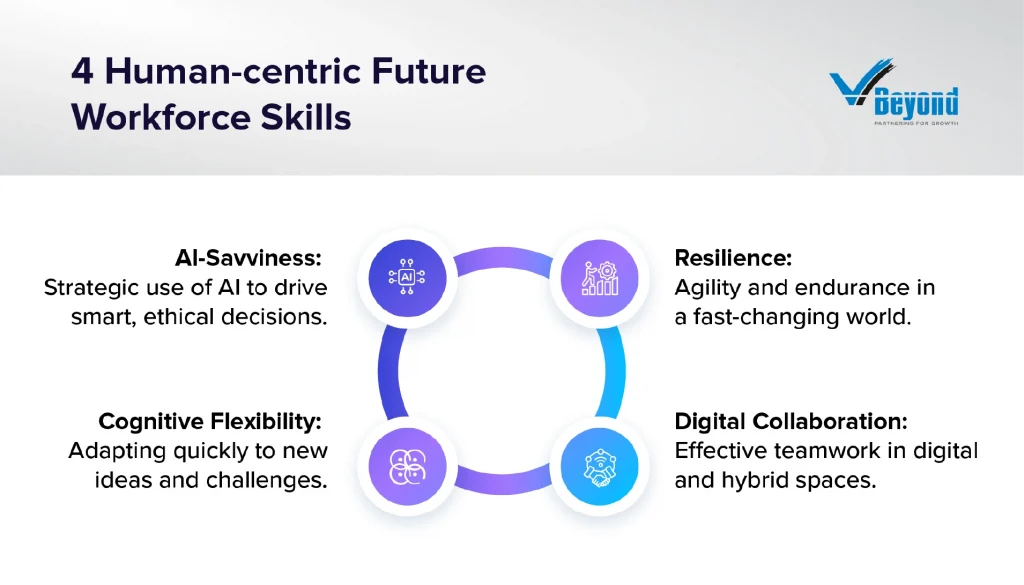Amid rapid technological changes, it is tempting to think the future of work and future workforce skills are all about machines, algorithms, and automation. Yet, as leaders, we know that true competitive advantage still lies within our people — their creativity, adaptability, and judgment. The organizations that thrive in 2025 will not simply be those that invest in the latest technology; they’ll be the ones that cultivate uniquely human-centric skills that AI and automation can’t replicate.
As we prepare a dynamic workforce to meet the demands of tomorrow, it’s clear that technical skills alone won’t be enough. The abilities that will truly set our teams apart are those that balance technological prowess with emotional intelligence, adaptability, and strategic vision. These are the human-centric skills that empower our people to not only navigate change but to shape it.
In this new era, where AI and human potential intersect, certain essential skills will emerge as the foundation of a resilient, future-ready workforce. Let’s explore these defining future workforce skills — and how we, as leaders, can champion their development to drive both our people and our organizations forward.
Global Talent Trends: Setting the Stage for the Future Workforce
In the past year, talent leaders, while preparing future workforce strategies, have confronted profound dualities. From the rise of generative AI (GAI) to the shifting labor market, they’ve faced the need to balance opposites: remote work versus return-to-office, hiring surges and headcount cuts, and the necessity of both AI-specific and deeply human skills. This dynamic environment has underscored a powerful truth: no matter the advances in technology, the heart of every organization remains its people.
The October 2024 LinkedIn Global Talent Trends report reveals the most pressing themes shaping today’s workforce. Let us explore the key shifts driving this change:
Labor Market Trends: A Move Toward Stability and Internal Mobility
- Hiring rates globally are experiencing a general slowdown, though some industries, such as technology, show signs of recovery. Certain sectors, including utilities, government, education, and consumer services, have maintained stable hiring levels despite the downturn. Notably, internal mobility has increased by 6% year-over-year, as companies increasingly leverage existing talent to fill new roles. This trend of moving employees within organizations highlights a strategic shift aimed at improving retention, career growth, and organizational resilience.
The Shift to Generative AI: A Major Opportunity for Early Adopters
- Generative AI (GAI) is recognized as a significant opportunity, with 8 in 10 global executives acknowledging its potential to improve efficiency in three critical ways: reducing time spent on repetitive tasks, increasing productivity, and enabling more strategic and creative thinking. However, most companies have yet to fully integrate GAI, leaving room for those who act quickly to gain a competitive edge by adopting AI tools and training their workforce in practical applications.
Soft Skills as a Priority in Hiring
- As GAI handles more routine tasks, organizations are increasingly valuing human-centric soft skills. Approximately 69% of U.S. executives report that they plan to prioritize candidates who bring essential soft skills to the table. The emphasis on mastering soft skills for workplace success reflects the rising importance of attributes that foster adaptability and collaborative problem-solving — capabilities that are difficult for technology to replicate yet essential for an agile workforce.
Learning and Development: A Focus on Broader Skill Development with AI
- AI adoption is not only about driving productivity but also about enhancing human capabilities. Employees proficient in GAI are shown to be five times more likely to develop skills such as creative ideation, design thinking, and emotional intelligence. Moreover, companies with a greater number of GAI-skilled employees see substantially higher promotion rates, both overall and in leadership roles. This data underscores the value of fostering an environment where AI skills are encouraged alongside continuous learning and professional growth.
GAI as Both an Opportunity and a Developmental Challenge
- The integration of GAI into the workforce brings both opportunities for increased engagement and productivity and challenges related to balancing technological and human skills. As employees become more AI-savvy, there is a parallel need to strengthen their distinctively human capabilities — such as communication, creativity, empathy, and critical thinking — to ensure a well-rounded, resilient workforce that thrives alongside technology.
These trends reveal a clear path forward: the future workforce will be a hybrid of human capability and AI, driven by a skill set that extends beyond technical knowledge. As leaders prepare for 2025 and beyond, the emphasis on human-centric skills is not a return to the old ways but a vital evolution in the era of AI. This sets the stage for the essential skills that will define the workforce of tomorrow — not just technical prowess, but the human attributes that truly drive organizational success.
Human-Centric Skills Set to Redefine Future Workforce Strategies and Organizational Success in 2025
As we prepare for a workplace where AI is woven into almost every facet of business, the most valuable skills are those that blend technology with uniquely human qualities. These are the abilities that will not only keep organizations resilient but will also empower teams to navigate change, drive innovation, and lead with empathy. Here are the essential skills every leader should prioritize to future-proof their workforce.
1. AI-Savviness: Mastering the Art of Human-AI Collaboration
As organizations integrate AI into daily operations, simply knowing how to use AI tools is no longer enough. AI-savviness goes a step further — it’s the ability to understand AI’s potential and limitations, apply it strategically, and collaborate effectively with AI systems to drive innovation. In 2025, AI-savviness will be an essential skill that combines technical know-how with critical thinking, allowing employees to leverage AI intelligently and ethically within their roles.
- Cultivate an AI-Ready Mindset and Strategic Thinking: Encourage a mindset that views AI as a collaborative enhancement rather than a replacement. Through scenario-based training, help employees understand AI’s potential and limitations, framing it as a tool that complements their unique skills. This mindset shift, reinforced by simulations of real-world challenges, supports employees in thinking strategically about AI’s role in achieving outcomes.
- Master Prompting and AI Communication Skills: Train employees in prompt engineering to improve their interactions with AI tools. Effective prompting — crafting precise, context-rich questions or instructions — is essential for getting accurate outputs. Encourage teams to experiment with different language techniques and share their insights, helping to build a shared knowledge base of effective prompt strategies that enhances overall organizational AI capabilities.
Equip employees with frameworks that guide them on when to lean on AI versus human judgment. These frameworks can include factors like ethical considerations, reliability of data, and potential for bias, enabling employees to make balanced, informed decisions about AI use.
- Encourage Cross-Functional Collaboration and Feedback Loops: Establish a culture of collaboration where employees from different departments work on AI-driven projects together. This broadens perspectives on AI applications and enables the sharing of prompt techniques and decision-making frameworks. Regular feedback loops — where teams reflect on AI project outcomes and adjust strategies — support continuous learning and adaptability in using AI effectively.
A vital subset of AI-savviness are human-AI integration skills focused on synthesizing human intuition with AI data for balanced, nuanced decision-making. This skill set emphasizes knowing when to rely on AI, interpreting AI outputs critically, and prioritizing human judgment in key areas. Here are the key components:
- Judgment Calibration: Develop the ability to balance AI insights with human experience. Teams should regularly evaluate AI recommendations alongside human-driven insights to learn when each approach adds the most value. This judgment calibration hones employees’ instincts on when to trust AI and when to apply their own intuition.
- Explainability Checkpoints: Integrate points within workflows where employees pause to interpret and question AI recommendations. By critically assessing data sources, assumptions, and any inherent biases, employees ensure that AI-driven decisions are transparent and aligned with human objectives, preventing AI from being taken at face value.
- Ethical Overrides: Train employees to recognize scenarios where human judgment should supersede AI outputs, especially when ethical or contextual nuances come into play. Through real-world case studies, employees learn to prioritize empathy, ethics, and context, maintaining a human-centered approach that upholds the “human touch” even within AI-supported decision-making.
2. Cultivating Cognitive Flexibility: Thinking Beyond Boundaries for a Dynamic Workforce
Cognitive flexibility refers to the mental ability to shift perspectives and approaches quickly. Unlike resilience, which is more about handling change, cognitive flexibility is about proactively rethinking problems, learning new concepts, and adapting strategies on the go. This skill enables workers to navigate complex, multi-dimensional challenges and come up with innovative solutions.
- “Contrarian Thinking Sprints” to Challenge Assumptions: Organize brief, focused sessions where employees tackle problems by intentionally adopting a contrarian viewpoint. For instance, if a team typically seeks to improve efficiency, they could explore, “How might we make this process slower but richer?” or “What if we intentionally broke this system — how would we rebuild it?” These sprints encourage teams to deconstruct their habitual thinking patterns, revealing new solutions by forcing a shift away from their default modes. By normalizing contrarian thinking, employees develop mental agility to question, challenge, and adapt approaches fluidly.
- “Insight-Borrowing” Practices for Rapid, Novel Solutions: To foster fresh perspectives, implement “insight-borrowing” exercises where employees are tasked with identifying and borrowing methods from unrelated industries or fields. For example, how might a supply chain team integrate design thinking principles, or how could a marketing team adopt principles from scientific research methods? This quick practice cultivates cognitive flexibility by bridging seemingly unrelated ideas, expanding problem-solving repertoires, and promoting agile thinking. The novelty of borrowed insights accelerates adaptability, as employees train themselves to source solutions from unconventional domains.
3. Achieving Digital Collaboration Proficiency: Key Steps for an Engaged and Dynamic Workforce
This skill centers on using digital tools to collaborate effectively across remote and hybrid settings. More than teamwork, it is about mastering digital communication platforms, managing virtual workspaces, and understanding how to foster engagement and productivity in a digital-first environment.
- Develop “Cognitive Load Management” Skills in Digital Environments: In digital spaces, employees face an overwhelming amount of information from various platforms. Cognitive load management is about equipping teams with techniques to handle this influx without losing focus or clarity. Introduce structured practices like information chunking, where tasks are broken down into manageable parts with specific time blocks, and intentional information filtering to prioritize essential content. By training employees to manage cognitive load proactively, they can navigate digital collaboration with greater clarity, reducing mental fatigue and enhancing sustained focus on critical tasks.
- Establish “Role-Based Digital Norms” for Structured Efficiency: One-size-fits-all approaches rarely succeed in digital collaboration. Instead, create role-specific digital norms that define collaboration expectations according to each role’s needs. For instance, customer-facing roles might have more real-time communication norms, while creative roles might prioritize asynchronous check-ins for deep work. This tailored structure minimizes unnecessary interactions, aligning each team member’s digital interaction style with their functional needs. Role-based norms improve collaboration by reducing interruptions and fostering a smoother workflow, allowing team members to engage in ways that are meaningful to their role and productivity.
- Implement “Digital Restorative Practices” to Counteract Virtual Fatigue: Digital fatigue is a pervasive issue in online collaboration. Rather than simply reducing screen time, introduce digital restorative practices. For example, use “visual variability” by alternating screen views (e.g., transitioning from grid views to speaker-only) to reduce visual monotony and eye strain. Additionally, establish brief “transition rituals” between meetings, such as a two-minute stretch or breathing exercise, to reset mentally and physically. These subtle but restorative practices allow teams to maintain energy and engagement, ensuring digital collaboration remains effective and sustainable.
4. Thriving Through Change: Building True Resilience
Resilience here is distinct as it focuses on adaptability under pressure, with an emphasis on enduring and thriving through challenges and setbacks. This skill is particularly important for handling the constant, sometimes abrupt, changes in a technology-driven workplace. While cognitive flexibility is about switching strategies, resilience is about emotional and psychological stability in the face of change.
- Cultivate “Adaptive Mindset Drills” for Real-Time Resilience: Resilience is strengthened by practicing adaptability in controlled settings. Adaptive mindset drills involve brief, simulated exercises where employees face unexpected shifts — such as altered project timelines or rapid re-prioritization scenarios. After each drill, encourage reflection on emotional responses and coping strategies. This approach normalizes the unpredictability of a fast-paced workplace and helps employees develop an instinctual, steady response to sudden changes, reinforcing their emotional and psychological endurance.
- Encourage “Resilience Narratives” for Peer-Based Support: A powerful way to build resilience is by learning from others’ experiences. Introduce “resilience narratives,” where team members regularly share stories of overcoming setbacks, coping mechanisms, and personal growth. A peer-based approach like this builds a collective resilience within the team, showing that challenges are shared and manageable. The act of sharing also provides emotional support and de-stigmatizes moments of struggle, making it easier for employees to see setbacks as temporary and surmountable.

Conclusion
With 2025 drawing near, it is increasingly clear that technological advancements alone cannot sustain organizational growth. While AI and automation will continue to transform processes, it is the unique human skills — adaptability, resilience, cognitive flexibility, and ethical judgment — that will truly differentiate thriving teams. By cultivating these abilities, we equip our workforce not only to respond to change but to drive it, ensuring that technology amplifies human potential rather than replace it.


